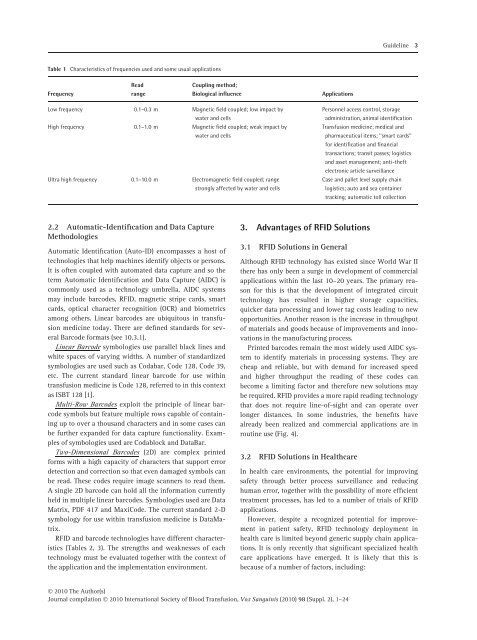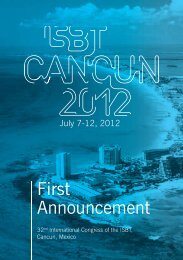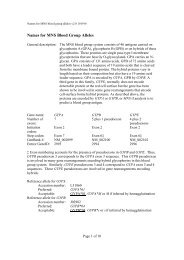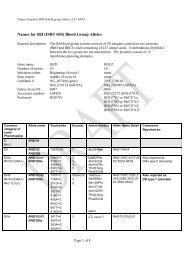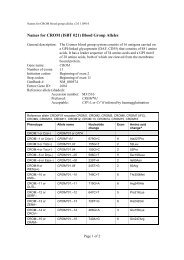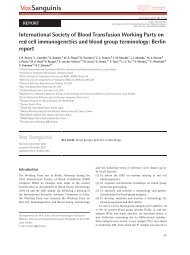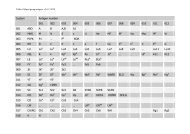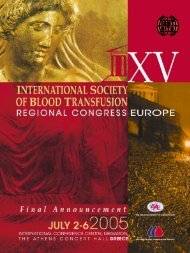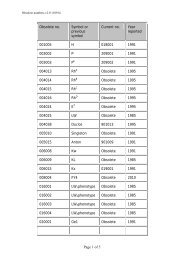Guidelines for the Use of RFID Technology in Transfusion Medicine
Guidelines for the Use of RFID Technology in Transfusion Medicine
Guidelines for the Use of RFID Technology in Transfusion Medicine
Create successful ePaper yourself
Turn your PDF publications into a flip-book with our unique Google optimized e-Paper software.
Guidel<strong>in</strong>e 3Table 1 Characteristics <strong>of</strong> frequencies used and some usual applicationsFrequencyReadrangeCoupl<strong>in</strong>g method;Biological <strong>in</strong>fluenceApplicationsLow frequency 0.1–0.3 m Magnetic field coupled; low impact bywater and cellsHigh frequency 0.1–1.0 m Magnetic field coupled; weak impact bywater and cellsUltra high frequency 0.1–10.0 m Electromagnetic field coupled; rangestrongly affected by water and cellsPersonnel access control, storageadm<strong>in</strong>istration, animal identification<strong>Transfusion</strong> medic<strong>in</strong>e; medical andpharmaceutical items; ‘‘smart cards’’<strong>for</strong> identification and f<strong>in</strong>ancialtransactions; transit passes; logisticsand asset management; anti-<strong>the</strong>ftelectronic article surveillanceCase and pallet level supply cha<strong>in</strong>logistics; auto and sea conta<strong>in</strong>ertrack<strong>in</strong>g; automatic toll collection2.2 Automatic-Identification and Data CaptureMethodologiesAutomatic Identification (Auto-ID) encompasses a host <strong>of</strong>technologies that help mach<strong>in</strong>es identify objects or persons.It is <strong>of</strong>ten coupled with automated data capture and so <strong>the</strong>term Automatic Identification and Data Capture (AIDC) iscommonly used as a technology umbrella. AIDC systemsmay <strong>in</strong>clude barcodes, <strong>RFID</strong>, magnetic stripe cards, smartcards, optical character recognition (OCR) and biometricsamong o<strong>the</strong>rs. L<strong>in</strong>ear barcodes are ubiquitous <strong>in</strong> transfusionmedic<strong>in</strong>e today. There are def<strong>in</strong>ed standards <strong>for</strong> severalBarcode <strong>for</strong>mats (see 10.3.1).L<strong>in</strong>ear Barcode symbologies use parallel black l<strong>in</strong>es andwhite spaces <strong>of</strong> vary<strong>in</strong>g widths. A number <strong>of</strong> standardizedsymbologies are used such as Codabar, Code 128, Code 39,etc. The current standard l<strong>in</strong>ear barcode <strong>for</strong> use with<strong>in</strong>transfusion medic<strong>in</strong>e is Code 128, referred to <strong>in</strong> this contextas ISBT 128 [1].Multi-Row Barcodes exploit <strong>the</strong> pr<strong>in</strong>ciple <strong>of</strong> l<strong>in</strong>ear barcodesymbols but feature multiple rows capable <strong>of</strong> conta<strong>in</strong><strong>in</strong>gup to over a thousand characters and <strong>in</strong> some cases canbe fur<strong>the</strong>r expanded <strong>for</strong> data capture functionality. Examples<strong>of</strong> symbologies used are Codablock and DataBar.Two-Dimensional Barcodes (2D) are complex pr<strong>in</strong>ted<strong>for</strong>ms with a high capacity <strong>of</strong> characters that support errordetection and correction so that even damaged symbols canbe read. These codes require image scanners to read <strong>the</strong>m.A s<strong>in</strong>gle 2D barcode can hold all <strong>the</strong> <strong>in</strong><strong>for</strong>mation currentlyheld <strong>in</strong> multiple l<strong>in</strong>ear barcodes. Symbologies used are DataMatrix, PDF 417 and MaxiCode. The current standard 2-Dsymbology <strong>for</strong> use with<strong>in</strong> transfusion medic<strong>in</strong>e is DataMatrix.<strong>RFID</strong> and barcode technologies have different characteristics(Tables 2, 3). The strengths and weaknesses <strong>of</strong> eachtechnology must be evaluated toge<strong>the</strong>r with <strong>the</strong> context <strong>of</strong><strong>the</strong> application and <strong>the</strong> implementation environment.3. Advantages <strong>of</strong> <strong>RFID</strong> Solutions3.1 <strong>RFID</strong> Solutions <strong>in</strong> GeneralAlthough <strong>RFID</strong> technology has existed s<strong>in</strong>ce World War II<strong>the</strong>re has only been a surge <strong>in</strong> development <strong>of</strong> commercialapplications with<strong>in</strong> <strong>the</strong> last 10–20 years. The primary reason<strong>for</strong> this is that <strong>the</strong> development <strong>of</strong> <strong>in</strong>tegrated circuittechnology has resulted <strong>in</strong> higher storage capacities,quicker data process<strong>in</strong>g and lower tag costs lead<strong>in</strong>g to newopportunities. Ano<strong>the</strong>r reason is <strong>the</strong> <strong>in</strong>crease <strong>in</strong> throughput<strong>of</strong> materials and goods because <strong>of</strong> improvements and <strong>in</strong>novations<strong>in</strong> <strong>the</strong> manufactur<strong>in</strong>g process.Pr<strong>in</strong>ted barcodes rema<strong>in</strong> <strong>the</strong> most widely used AIDC systemto identify materials <strong>in</strong> process<strong>in</strong>g systems. They arecheap and reliable, but with demand <strong>for</strong> <strong>in</strong>creased speedand higher throughput <strong>the</strong> read<strong>in</strong>g <strong>of</strong> <strong>the</strong>se codes canbecome a limit<strong>in</strong>g factor and <strong>the</strong>re<strong>for</strong>e new solutions maybe required. <strong>RFID</strong> provides a more rapid read<strong>in</strong>g technologythat does not require l<strong>in</strong>e-<strong>of</strong>-sight and can operate overlonger distances. In some <strong>in</strong>dustries, <strong>the</strong> benefits havealready been realized and commercial applications are <strong>in</strong>rout<strong>in</strong>e use (Fig. 4).3.2 <strong>RFID</strong> Solutions <strong>in</strong> HealthcareIn health care environments, <strong>the</strong> potential <strong>for</strong> improv<strong>in</strong>gsafety through better process surveillance and reduc<strong>in</strong>ghuman error, toge<strong>the</strong>r with <strong>the</strong> possibility <strong>of</strong> more efficienttreatment processes, has led to a number <strong>of</strong> trials <strong>of</strong> <strong>RFID</strong>applications.However, despite a recognized potential <strong>for</strong> improvement<strong>in</strong> patient safety, <strong>RFID</strong> technology deployment <strong>in</strong>health care is limited beyond generic supply cha<strong>in</strong> applications.It is only recently that significant specialized healthcare applications have emerged. It is likely that this isbecause <strong>of</strong> a number <strong>of</strong> factors, <strong>in</strong>clud<strong>in</strong>g:Ó 2010 The Author(s)Journal compilation Ó 2010 International Society <strong>of</strong> Blood <strong>Transfusion</strong>, Vox Sangu<strong>in</strong>is (2010) 98 (Suppl. 2), 1–24


